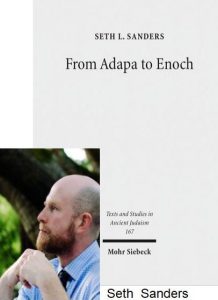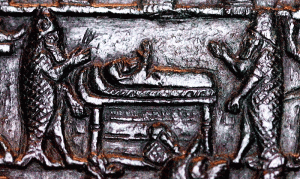 Continuing to share my reading of Seth Sanders’ From Adapa to Enoch, Scribal Culture and Religious Vision in Judea and Babylon, last discussed at Ascent of the Sage: “From Adapa to Enoch”, part 2 . . . .
Continuing to share my reading of Seth Sanders’ From Adapa to Enoch, Scribal Culture and Religious Vision in Judea and Babylon, last discussed at Ascent of the Sage: “From Adapa to Enoch”, part 2 . . . .
We come now to chapter 2, “I Am Adapa!” The Divine Personae of Mesopotamian Scribes.
If we want to understand how ancient scholars related to their universe, their revealed texts and revealers, the best collections of sources we have, spanning two to three thousand years up to the first century CE, are the cuneiform records of Mesopotamia. In the next chapter Sanders begins to compare Judean texts.
In this chapter (2) Sanders examines the nature of the cosmos among these ancient scribes and how they went about understanding, studying and acting on it.
In addition to the texts, there is the visual imagery of divine beings, divine sages or apkallu, to help us with our inquiry.
We have images of a patient (sick, hence possessed or inflicted by a demon) surrounded by superhuman fish-apkallu standing where exorcists would be positioned.
We have royal inscriptions of the enthroned king framed by bird-apkallu maintaining cosmic order from the seat of royal power.
Scholarly participation in supernatural presence was not confined to exorcism: the economists and political scientists of their day, diviners summoned the gods to meet together in divine assembly so that the diviner could be present to hear and transmit their verdict for the country’s future. (Sanders, 72)
“Medical practice” and “political advisors” were thus the more practical pursuits of scholars. But what are the boundaries between science and what we would relegate to mumbo-jumbo in their world? And did the scholars or scribes really become, in their own minds, supernatural sages (apkallu)? Did they really believe they could journey to heaven and meet with the gods?
At this point we find an interesting connection with another book I have been posting about. It is interesting to compare the concepts of early Judean scribes to their Hebrew text — see the two posts on Nanine Charbonnel’s chapter 2, The Sacred and Creative Power of the Hebrew Text and A God Bound to the Mechanics of Language. Seth Sanders writes,
If cuneiform was the secret of Mesopotamian scribes, the ultimate decipherer of this secret was the semi-human sage Adapa, at once the symbol and the patron saint of the scribe. Probably the single most popular mythic hero in Mesopotamian literature, Adapa beat out even Gilgamesh. As Michalowski notes, “no other hero of a canonical text is so often encountered in other compositions.” This is not surprising, since he would have been so sympathetic to the scribes who produced those compositions. He is supposed to have authored omen collections, fathomed the deepest secrets of words and magic, and broken the wings of the South Wind by the sheer power of his speech. He was of paramount importance to the people who created cuneiform culture.
Adapa is crucial as a phenomenological starting point in our comparison of scribal heroes. As the best-documented ancient Near Eastern figure who ascends to heaven, negotiates with gods, transmits revelation, and fights demons to heal the sick he is simultaneously the closest thing Mesopotamia has to Moses, Enoch and the shaman of North Asian societies. Seen horizontally, from a view of cultures side by side, he represents a broad comparative type: the mediator, who moves between the worlds of gods and humans. (Sanders, 73. My bolding in all quotations)
Adapa is a figure of knowledge and power (see the previous post in this series). He is also worn as a ritual mask. And as we saw in the previous post, his function changes over time as political circumstances change.
In order to grasp something of the way the natural and divine worlds were conceptualized in Mesopotamian culture we need to set aside our dualistic notions of spirit powers and entities. To us, the spirit realm stands against the natural world, yet such a division between the two needs to be set aside, Sanders emphasizes at length. We think of God and spirit beings as not found literally in physical manifestations like idols of stone, or in natural phenomena like earthquakes and storms.
Mesopotamian texts and images portray the divine beings interacting with, present with, humans, both occupying the same space, and in some cases the human speaker actually claims to be the divine Adapa himself.
I am Adapa sage of Eridu [= location of watery source of secret knowledge]
I am the man [= servant] of Asalluhi [= the god of exorcism]
Enki [= creator and master of the demons causing the illness] the great lord has sent me to cure the man in his illness!
In what sense did the speaker understand himself to be Adapa?

Advances in understanding the Mesopotamian view of the supernatural vis a vis the natural world have come, Sanders explains, through exploring more deeply the nature of Mesopotamian science. And here I take a detour to have a closer look at some of the sources Sanders calls upon, work by the Assyriologist Francesca Rochberg.
Before the “World of Nature”
Imagine not having a concept of “the natural world” or “nature”. We take the concept for granted and that makes it difficult for us to appreciate that it has not always existed.
A key insight has come from the history of science. Exploring Mesopotamian scholars’ criteria for meaning and truth, Francesca Rochberg has shown that cuneiform scholarship tended to see the material world as composed of signs: reality itself is semiotic. Such an ontology does not presuppose a purely non-linguistic physical nature in opposition to culture, and in fact the history of science has shown that an explicit concept of nature is not necessary to all scientific inquiry, citing ancient China and Mesopotamia as cases where forms of science thrived without it (Lloyd 2012:64). (Sanders, 77)
What were the “subjects” of interest to Mesopotamian scholars?
Various forms of divination: astronomy and astrology, examination of sheep’s entrails, lexical texts (lists of synonyms, grammatical forms, etc.), diagnostic and therapeutic medical texts, magical texts, incantations . . . Continue reading “Scholars, Divinities and How the Cosmos was Understood “Scientifically” B.C.E.”


